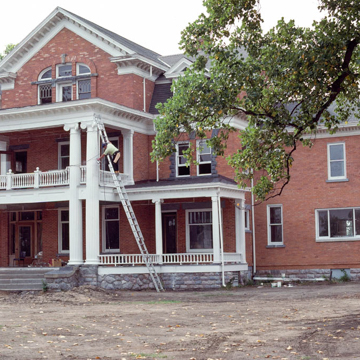You are here
Louis F. Adado Riverfront Park and Trail System (Lansing Riverfront Park)
Although much smaller in scale and less grand than San Antonio's Paseo del Rio, this urban park along the Grand River was also designed for spontaneous and planned individual and group activities. The first phase was completed for the nation's bicentennial in July 1976. The park and the riverwalk extend to the north and the south, and, like San Antonio's, allow direct contact with the Grand and Red Cedar rivers for several miles. Visual and performing arts events, exhibitions, and special festivals occur in the park. The land along the river was reclaimed, and most structures were removed. The salt storage shed was transformed into a natural amphitheater, and the railroad bridge was turned into a pedestrian walkway that links the east and west sides of the river. Berms and plantings add a three-dimensional quality to the area. The scenic biking, jogging, and walking trail connects parks and activity, cultural, and civic centers. These include the Lansing Center (1986–1987, TMP Associates; 333 E. Michigan Avenue); the Lansing City Market (2010; 325 City Market Drive); William A. Brenke Sculpture–Fish Ladder (1980–1981, Joseph E. Kinnebrew, sculptor, and Robert O'Boyle, landscape architect); Turner-Dodge House (1903 remodeling, Darius Moon; 1995 exterior restoration, Richard C. Frank; 100 E. North Street); Oldsmobile Park (1996, HNTP, architects; 505 E. Michigan Avenue), home of the minor league baseball team the Lansing Lugnuts; the Women's Hall of Fame (1903, Cooley-Haze House; 213 W. Main Street); and Potter Park Zoo (1912–present; 1301 S. Pennsylvania Avenue).
Writing Credits
If SAH Archipedia has been useful to you, please consider supporting it.
SAH Archipedia tells the story of the United States through its buildings, landscapes, and cities. This freely available resource empowers the public with authoritative knowledge that deepens their understanding and appreciation of the built environment. But the Society of Architectural Historians, which created SAH Archipedia with University of Virginia Press, needs your support to maintain the high-caliber research, writing, photography, cartography, editing, design, and programming that make SAH Archipedia a trusted online resource available to all who value the history of place, heritage tourism, and learning.









